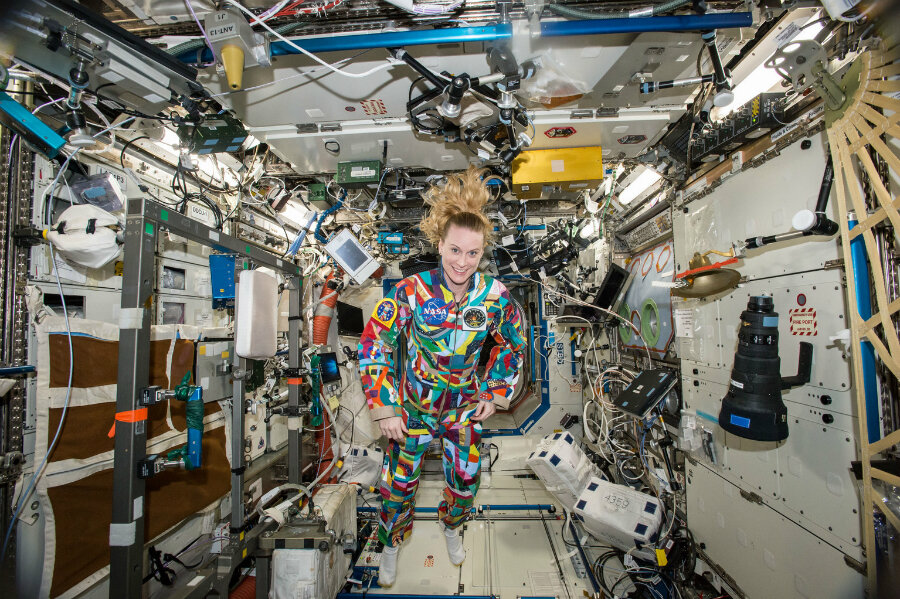Take a video tour of the International Space Station
Loading...
To travel to the International Space Station (ISS), you could train for tens of thousands of hours with NASA to become an astronaut. Or you could just watch it on ultra-HD, 4K video.
NASA has released ultra-high-definition video of footage filmed with a fisheye lens of inside the space station. The fisheye lens, which provides extreme focus and depth-of-field, improves the viewing experience.
The video comes as there is increasing fascination among Earthlings in space travel and the hope of visiting space themselves. Millions have liked NASA and other space agencies' social media posts of the views from space, watched Facebook videos of spacewalks, and chatted with astronauts while they floated above Earth. And on the horizon are commercial and tourism ventures to bring private citizens to low-orbit and space.
For now, though, we’ll have to settle for the ultra-HD preview.
The 60-frames-per-second video offers views inside the ISS and its equipment. The ISS is a metallic abode for up to six astronauts living in orbit 249 miles above Earth and is full of scientific equipment. The 18-minute video, produced by Harmonic for NASA TV UHD, was released by the space agency on Oct. 27.
The non-narrated tour with ambient background music slowly glides through equipment- and wired-filled rooms until it ends with gazing out at planet Earth beyond the space station windows.
NASA and other space agencies regularly post content online, and the ISS is outfitted with HD cameras. But NASA and private companies are fast upgrading their offerings.
Space VR, a private company, plans to send its first virtual reality (VR) satellite into orbit in 2017, soon offering footage that can be viewed on smartphones or virtual reality headsets. SpaceVR is building a VR satellite, outfitted with 4,000 image sensors for high-resolution 3-D video, The Christian Science Monitor reported recently. The company will combine footage from each camera in the rig to produce a 360-degree video. Through its partnership with aeronautics supplier NanoRacks, Space VR will have the satellite launched from the ISS.
NanoRacks began working with SpaceVR in 2015 and has since partnered with Blue Origin, the private aerospace company started by Amazon founder Jeff Bezos.
"SpaceVR promises to open a new era in connecting consumers worldwide to the beauty of outer space, and we are ready to be part of that effort," said Jeffrey Manber, chief executive officer of NanoRacks, in a statement.
Blue Origin is also one of a number of companies that are in a race to bring private citizens to space. Many of these companies seek to bring space tourists into low-orbit, with these hopeful passengers willing to pay as much as $250,000 a seat. Virgin Galactic, founded by Richard Branson, has already sold tickets to about 700 people to become some of the first tourists to travel to space – or at least to low orbit, The Christian Science Monitor reported in February. The travel log includes celebrities Stephen Hawking, Brad Pitt, and Katy Perry. Virgin Galactic received an operator’s license from US regulators in August to resume testing of its SpaceShipTwo craft, after a previous model was destroyed in a fatal accident in 2014, that resulted in the death of one pilot and severe injuries to the other.
Virgin Galactic has not yet announced when the vehicle will make its first test flight, but chief executive officer George Whitesides told Fortune in May that the company hopes to send satellites, if not people, into space by 2017.
Two private companies also announced in October they will have facilities available by 2020 as part of a NASA program to use the ISS for commercial space activities. The two companies are Bigelow Aerospace and Axiom Space.
The companies have said private spaceflight will allow NASA to turn its attention to reaching Mars while allowing more people than ever to experience space.
"Hopefully, if we're successful in the private-sector community, NASA's going to save a boatload of money, on multiple locations [in orbit] – not just one – with more volume than they've ever had before," Bigelow founder and chief executive Robert Bigelow said in October.







